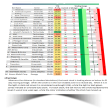by Jon Ruff, AllianceBernstein
Recent movements in asset prices suggest that markets have forsaken any possibility of an inflation outbreak in the next decade. We believe that view is far too sanguine.
In 2011, inflation in the US was expected to reach 2.4% by 2013, according to consensus estimates. But since then, consensus expectations for 2013 consumer price inflation in the US have fallen by nearly 100 basis points (b.p.) to 1.5%, with a third of the drop coming in the past three months. Similar trends have unfolded in China, with inflation expectations for 2013 dropping by 150 b.p. from peaks two years ago.
Inflation Expectations Have Tumbled
Medium-term inflation expectations in the US have also tumbled; the five-year break-even inflation rate, measured by nominal Treasury yields minus yields on Treasury Inflation Protected Securities (TIPS), starting five years from now has fallen 75 b.p. from 2011 highs. Here, too, a third of the fall has come in just the past three months.
This decline in expectations is understandable. After years of unprecedented fiscal stimulus and unconventional monetary policy by the US Federal Reserve and other major central banks around the world, most economies continue to operate well below potential and without even a whiff of consumer price inflation. Fiscal policy has turned neutral at best (outside Japan) and the Fed is contemplating a tapering of monetary policy. If inflation wasn’t sparked by aggressive fiscal and monetary policies globally, then why should it arise now with these policies winding down?
Markets May Have Gone Too Far
We agree that, in the short term, the outlook for consumer price inflation in the US and China is relatively benign. However, markets seem to have gone a step too far and discounted even the possibility of an inflation outbreak in the long term. We strongly disagree with this latter consensus and believe it has created an attractive entry point for investors to incorporate inflation protection into their portfolios.
The re-rating of inflation tail risks can be seen in survey data, in inflation derivative markets and in the price of gold. As the left chart in the display shows, economists are as confident today as they have been at any point in the past 60 years that inflation will not tick up (from depressed levels) in the near term. This confidence carries into the inflation derivatives market. The price of options that pay off if long-term inflation expectations jump by certain amounts above prevailing expectations are at post-crisis lows and less than half their 2009 values. Perhaps most spectacularly, the right chart shows that the value of disaster insurance embedded in the price of gold crashed from nearly US$500/oz in January to zero on June 28.
Real Assets Are Extremely Cheap
Partially as a result of this inflation risk re-rating, every real asset category in our universe—assets that tend to perform well in inflationary environments—underperformed broad stock indices in the second quarter. This includes stocks and futures of precious metals, industrial metals, energy and agriculture, as well as real estate around the world. Even TIPS trailed equities.
The good news is that this re-rating has left inflation protection and the broad universe of real assets at their cheapest levels since the global financial crisis. Barring a collapse of growth in China or the resurfacing of global deflation fears, we believe real assets should at least keep pace with global equities in the coming years. And if even the possibility of an inflation outbreak gets priced back into the markets, then we expect real assets to post dramatic outperformance.
The views expressed herein do not constitute research, investment advice or trade recommendations and do not necessarily represent the views of all AllianceBernstein portfolio-management teams.
Jon Ruff is lead Portfolio Manager and Director of Research for Real Asset Strategies at AllianceBernstein.
















